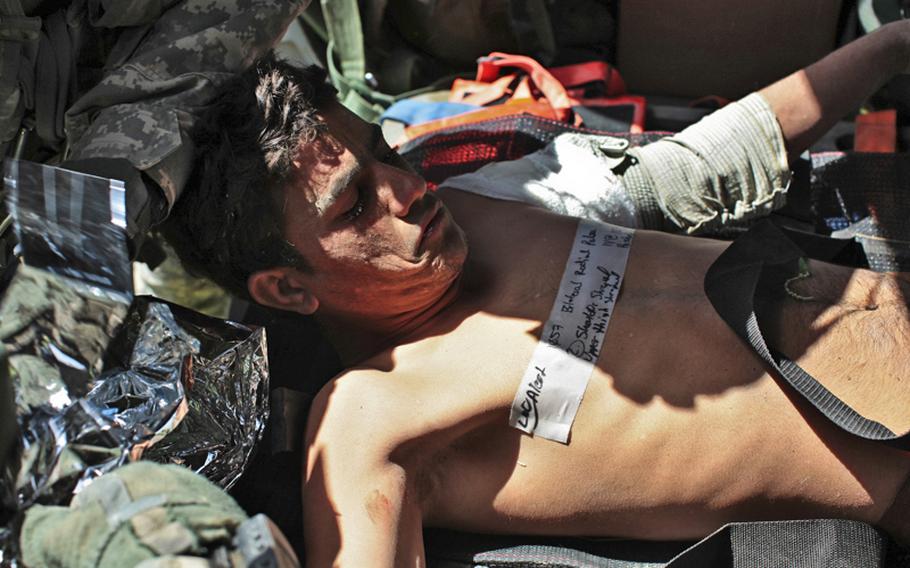
A wounded Afghan soldier is loaded onto a U.S. medical evacuation helicopter after being wounded Sept. 16 in a bomb blast in Zhari district, Kandahar province, Afghanistan. (Drew Brown/Stars and Stripes)
First in a two-day seriesKANDAHAR AIR FIELD, Afghanistan — Hardly a day passes when the American flag above the 101st Combat Aviation Brigade’s headquarters here is not flying at half-staff.
With U.S. and other coalition forces stepping up operations against Taliban insurgents in southern Afghanistan, more dead and wounded are being pulled off the battlefield than ever before.
Since deploying in March, helicopter ambulance crews with the brigade’s Task Force Shadow have flown more than 2,000 missions, evacuating more than 2,500 patients, according to Maj. Jason Davis, commander of Company C, 6th Battalion.
That’s more than twice the rate that helicopter ambulance crews in southern Afghanistan were flying this time last year, he said.
The increase reflects just how sharply fighting in the region has spiked in recent months, a result of President Barack Obama’s decision to deploy 34,000 additional U.S. troops. Most were deployed to southern Afghanistan, where they, along with mostly British and Canadian forces, are trying to wrest control of strategically important areas from the Taliban, including the city of Kandahar and the Arghandab and Helmand river valleys.
“You’ve got more people fighting the enemy in places where we haven’t been in a long time,” said Davis, 35, of Steilacoom, Wash. “And when you’ve got more people fighting, you’re going to have more missions.”
More than 540 NATO troops — two-thirds of them American — have been killed in Afghanistan this year, making 2010 the deadliest year of the war, according to icasualties.org, a website that tracks coalition fatalities. More than 1,200 American troops have died in the war since U.S.-led forces ousted the Taliban in 2001.
Yet Afghans are bearing the brunt of the war in ever increasing numbers. According to a United Nations report issued in August, at least 3,268 Afghan civilians were killed or wounded during the first half of 2010 — a 31 percent increase over the same period last year. Casualties among children rose by more than half. Taliban attacks were to blame for three-quarters of all civilian casualties, the U.N. found.
Those figures appear to be even worse in southern Afghanistan. About 65 percent of the casualties Task Force Shadow has evacuated in the past six months have been either Afghan soldiers or civilians, Davis said. Almost half have been children.
“The worst are the kids,” said Staff Sgt. Bradley Robbins, 34, of Clarksville, Tenn., a flight medic. “A lot of us out here have kids, and it doesn’t make it any easier.”
As fighting has increased, crews are flying in under fire more often.
“This deployment is way more hectic, way more hairy,” said Sgt. Derrick Costine, a Black Hawk crew chief on his second deployment here. “There’ve been a lot more missions and a lot more contact. The last time I was here [in 2008] I only took enemy contact twice. But this time, it’s been countless.”
The trauma and stress that medics and other crewmembers encounter daily is staggering; soldiers missing limbs or torn apart by explosions, others dying from gunshot wounds, and the daily race against time to get their patients to the hospital before they die.
“I see more trauma out here in one medevac shift than I would’ve seen in a whole year with an infantry company,” said Robbins, who is on his fourth combat deployment, the second as a flight medic.
Because they deal with such trauma on a daily basis, the crews of Task Force Shadow are exceptionally close-knit. Those not on duty frequently meet returning crewmembers on the flight line after a stressful mission and help them ready their aircraft for the next call.
“It helps you get it all off your chest and get ready for the next mission,” Robbins said.
The soldiers must compartmentalize their emotions to stay focused.
“You get the ones that you know aren’t going to make it, those are the hardest,” said Sgt. 1st Class Richard Miller, 40, of San Antonio, who is on his fourth combat deployment. “You try not to think about it too much. You just try to provide the best possible care you can, and get them to Role 3.”
Role 3 is the military hospital at Kandahar Air Field. If the wounded get there alive, they almost always survive.
Even as support for the war slips back home, the crews of Task Force Shadow frequently express a devotion to their mission that leaves little room to question their role in the war.
“I love what I do,” said Miller, a 21-year veteran. “I was a ground medic for most of my career, but this is the most gratifying thing I’ve ever done. We have a positive impact on the guys who need us the most.”
Chief Warrant Officer 3 Shayne Lingg, 31, of Shelby, N.C., acknowledged that a lot of people have doubts about how to win in Afghanistan. “But one thing nobody has any doubts about is what we’re doing to help the guys out on the ground.”
“Sometimes, it seems like a losing battle,” admitted Costine. “But this mission for me is important because of the mission they [the infantry and other ground units] are doing out there. If we don’t fly, people die.”